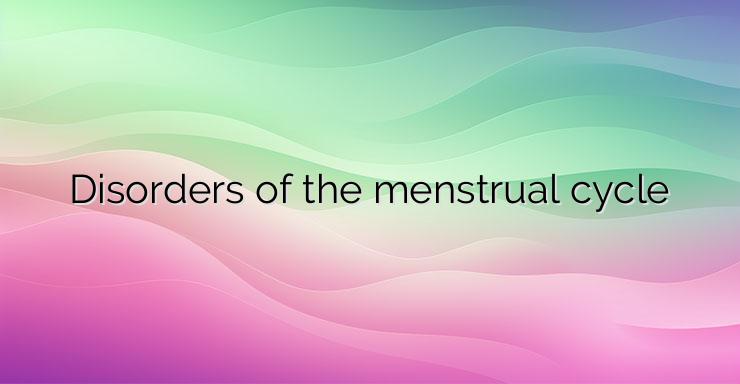The menstrual cycle is an expression of the hormonal changes that occur monthly in the female body and are associated with preparation for fertilization. It has a normal duration of 21 to 35 days – an average of 28 days – and is under the control of the hypothalamic-pituitary-ovarian axis. Disturbance at any level of this axis leads to disturbances in the menstrual cycle. The menstrual cycle consists of two phases: the follicular phase and the luteal phase. During the follicular phase, the level of estrogens gradually increases, the uterine lining thickens and new glands are formed. At the end of the follicular phase, there is a peak in the level of luteinizing hormone, which causes the release of a mature egg (ovulation). During the luteal phase, mainly progesterone is secreted, which, when fertilization occurs, forms the corpus luteum of the pregnancy, and when it does not, the red corpus (corpus rubrum), and subsequently – the corpus albicans. Menstruation is monthly bleeding that sheds the hypertrophied endometrium due to failure of fertilization. Menstruation usually lasts 3-7 days and is characterized by the release of up to 80 ml of blood. The following menstrual disorders differ depending on the duration and abundance of menstruation: Hypomenorrhea – weak, scanty bleeding; Hypermenorrhea – profuse bleeding; Polymenorrhea – a menstrual cycle that is shorter than 21 days; Oligomenorrhea – menstrual cycle longer than 35 days; Amenorrhea – lack of menstruation; Dysmenorrhea – profuse, heavy and painful menstruation, the etiology of which is not hormonal; Menorrhagia – bleeding associated with menstruation and lasting more than 7 days; Metrorrhagia – profuse bleeding that is not associated with menstruation. Uterine bleeding is also a disorder of the menstrual cycle. They occur both among young girls and among menopausal women – in the case of the latter, their appearance is always an expression of an ongoing pathological process. The causes of uterine bleeding are the most diverse, which is why they are divided into two main groups: organic and functional. Organic hemorrhages occur as a result of inflammatory diseases, benign and malignant tumors, ectopy, trauma, etc. Functional uterine bleeding is due to dysfunction in the hypothalamic-pituitary-ovarian axis. The reason for their appearance may be the intake of certain medications (oral contraceptives, anticoagulants, etc.). They are also characteristic of the period after the onset of the first menstruation and the period around menopause. Functional uterine bleeding includes estrogen and progesterone breakthrough bleeding and estrogen withdrawal bleeding. Menstrual cycle disorders also include the absence of menstruation – amenorrhea. Amenorrhea can be primary or secondary. The term primary amenorrhea refers to the absence of the first menstruation (menarche) after the age of 16 with or without the development of secondary sexual characteristics or with their virilization. The causes of primary amenorrhea can be the most diverse:congenital anomalies such as vaginal and cervical atresia, anomalies in the development of the hymen – hymen imperforans (impassable hymen), Mayer-Rokitansky syndrome, which is expressed by congenital aplasia of the uterus and the upper 2/3 of the vagina; tumors – prolactinoma, adrenal and ovarian; genetic abnormalities – Turner syndrome. Primary amenorrhea is also present in Morris syndrome, the so-called testicular feminization, in which a male genotype is present but a female phenotype due to a lack of testosterone receptor sensitivity. The reason for lack of menstruation can be strong stress, heavy physical training, anorexia, etc. The second type of amenorrhea is the so-called secondary amenorrhea, in which there is an absence of menstruation for more than three menstrual cycles. Among the causes of secondary amenorrhea are Asherman’s syndrome – uterine adhesions; Sheehan’s syndrome (postpartum hypopituitarism) – necrosis of the pituitary gland due to severe blood loss; polycystic ovary syndrome; stress, malnutrition, etc. Disorders of the menstrual cycle are diverse and relatively common. For their diagnosis, it is necessary to take a thorough medical history, take secretions for microbiology and smear, colposcopy, transvaginal ultrasonography, hormone research and, if necessary, more informative studies such as MRI, scanner. Treatment of menstrual disorders depends on their etiology. Hormonal preparations are used for hormonal disorders in the hypothalamus-pituitary-ovary axis. Nonsteroidal anti-inflammatory drugs (NSAIDs) are prescribed symptomatically. Surgical treatment is also possible.Hormonal preparations are used for hormonal disorders in the hypothalamus-pituitary-ovary axis. Nonsteroidal anti-inflammatory drugs (NSAIDs) are prescribed symptomatically. Surgical treatment is also possible.Hormonal preparations are used for hormonal disorders in the hypothalamus-pituitary-ovary axis. Nonsteroidal anti-inflammatory drugs (NSAIDs) are prescribed symptomatically. Surgical treatment is also possible.


Leave a Reply